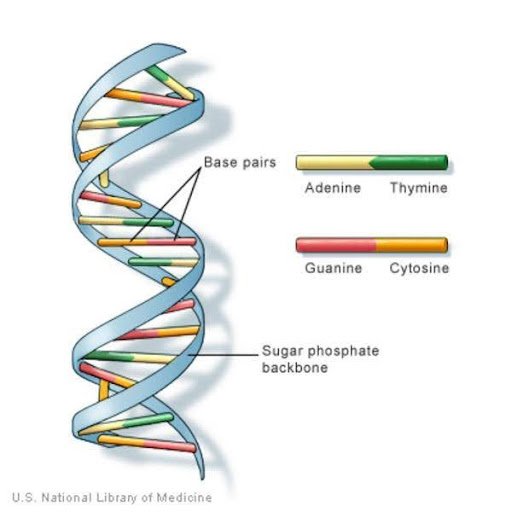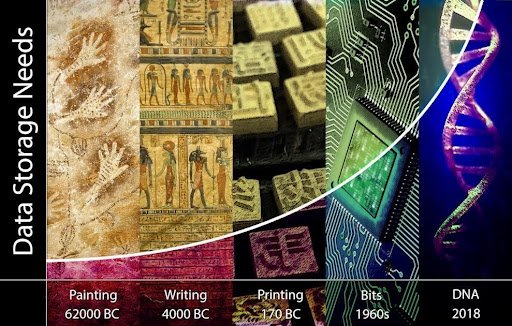The population of the world is around 8 billion and is constantly growing. With the advent of time, technologies like the Internet of Things (IoT), edge computing, and Artificial Intelligence (AI) have become a part of our daily lives. A lot of data is generated every second. Every time our interaction with the phone creates data.
IDC (Internet Data Center) states we will have 175 Zettabytes of data by 2025. This data is so huge that if we have DVDs to store this data, the stack of DVDs would be large enough to wrap the earth 222 times. Recent research has demonstrated the capability of using DNA molecules to store genetic information, encode digital information, and do useful computations.

What is DNA?
DNA is short for deoxyribonucleic acid. It is basically a hereditary material consisting of a group of molecules carrying genetic information about a living organism. We can also call it the fingerprint of a living organism. It’s made up of long chains of molecules called nucleotides, which contain the instructions for an organism’s growth, development, functioning, and reproduction.
Each nucleotide is composed of one of four nucleobases (adenine [A], thymine [T], cytosine [C], or guanine [G]) and a sugar-phosphate backbone. DNA encodes genetic information like data can be encoded onto electronic-based storage devices. That’s why we called it the natural storage device.
Ages of Data
In the early history of humankind, the only way of storing data and conveying information was by painting and carving. Lascaux Cave Paintings, a collection of paintings (approximately 20,000 years old) discovered in caves of the Dordogne region of southwestern France. These paintings include animals such as horses, bulls, and deer, as well as abstract symbols that give insights into the lives and beliefs of early humans, possibly serving as a form of communication or storytelling within their community. Sumerian Cuneiform Tablets are one of the oldest forms of writing (around 3500 BCE).
They were used to record a variety of information, such as temple activities, trade, stories, and myths. By this time, humans had developed a lot of storage devices like Magnetic Tape, Hard Disk drives, SSDs, USB, NVMe (Non-Volatile Media Express), etc. After many developments, we are able to store 4TB of data on a single SD card, which is so compact that we can handle it with our fingertips. Now, we are in the age of big data. So, the world is searching for a new mode of data storage devices. And one possible answer to their questions is “DNA.”
“DNA is really good at storing information because it’s much more compact (3-to-6 orders of magnitude) and more reliable than electronic memory. It can hold a lot of data and lasts much longer without getting damaged”, said researchers at RIT (Rochester Institute of Technology).

DNA as a Storage Device
“We are in the age where vast data is generated every second and needs to be stored somewhere. The conventional way of storing data is in data centers. Building more data centers isn’t the optimal solution. Each data center consumes power equivalent to a city block, making it unsustainable to maintain, construct, and operate traditional data centers at an increasing rate,” study co-author Amlan Ganguly, head of the Department of Computer Engineering at the Rochester Institute of Technology (RIT), said in a statement.
Companies such as Microsoft have also recognized DNA as one candidate to manage and store skyrocketing amounts of data. DNA storage is also much more expensive to manufacture. The cost of chemically synthesizing DNA is still high at $3,500 per 1 megabyte (MB) of information. The capacity of the DNA to store data is 200 petabytes (PB) per gram. The latest research has revealed that just four grams of DNA could store the annual global digital information.
DNA as a Computation Device
DNA computing is an exciting technology in computing. Instead of silicon-based electronic circuits, it utilizes molecular reaction techniques to compute DNA molecules. Scientists (Arnav Solanki et al.) have created a new Biocomputing chip that makes calculations using a DNA substrate.
This is a platform or surface on which instructions are read and used to perform tasks, kind of like a special type of paper on which instructions are written, including mathematical operations indispensable to big data processing and artificial intelligence (AI) training.
Researchers (Arnav Solanki et al.) described the new Biocomputing platform in the journal PLOS One. DNA-based devices have previously been used to encode data on a small scale, but this prototype chip also uses DNA to process data.
Researchers (Seth Shipman et al.) have previously built DNA-based storage devices, encoding the DNA molecules of bacteria with a video of a horse in 2017. The comparative analysis outlined in a 2018 paper published in the journal 3Biotech revealed that data transfer rates on DNA-based storage platforms are considerably slower than those of conventional storage devices.
In the study, Amlan Ganguly and his team explored techniques for manipulating DNA at the molecular level to replicate numerous functions analogous to those of computing, including sequencing (data reading) and synthesizing (data writing).
The encoded data on the DNA by nicking (cutting of DNA) strands at specific locations to represent the 1s and 0s of binary, and represented different calculations by using a network of microfluidic channels. This transfers fluids around an integrated circuit to perform functions as chemical reactions. DNA processing can also offer “unprecedented parallelism’, the ability of modern computer systems to perform multiple tasks simultaneously, said Amlan Ganguly in their paper.
DNA is now the best option in this era, where data storage is a big problem due to its large storage capacity. DNA is incredibly good at storing information and can last a really long time. But now it’s not only about storage; scientists are exploring how to use DNA for computations. They have built Microfluidic devices that can store data and perform useful computations. This new Microfluidic device is a proof-of-concept, but the scientists hope that by scaling the device, it can one day be used to train AI systems.
Of course, there are still some hurdles to overcome, like cost and performance optimization, but possibilities are endless. Imagine a future where all our data is stored in tiny DNA molecules, and computers solve complex problems using biology instead of silicon chips. It’s a wild idea, but it just might be the key to unlocking a whole new world of technology.
References
- https://data.worldbank.org/indicator/SP.POP.TOTL
- World Population Clock: 8.1 Billion People (LIVE, 2024) – Worldometer (worldometers.info)
- What Is Edge Computing? | IBM
- https://medlineplus.gov/genetics/understanding/basics/dna/
- Church G, Gao Y, Kosuri S. Next-Generation Digital Information Storage in DNA. Science (New York, NY). 2012;337:1628. doi: 10.1126/science.1226355
- https://www.seagate.com/files/www-content/our-story/trends/files/idc-seagate-dataage-whitepaper.pdf
- Blawat M, Gaedke K, Huetter I, Chen XM, Turczyk B, Inverso S, et al. Forward error correction for DNA data storage. Procedia Computer Science. 2016;80:1011–1022. doi: 10.1016/j.procs.2016.05.398
- Church G, Gao Y, Kosuri S. Next-Generation Digital Information Storage in DNA. Science (New York, NY). 2012;337:1628. doi: 10.1126/science.1226355
- Researcher bridges biology and computing with processing in DNA storage | RIT Venture Fund | RIT
- Blawat M, Gaedke K, Huetter I, Chen XM, Turczyk B, Inverso S, et al. Forward error correction for DNA data storage. Procedia Computer Science. 2016;80:1011–1022. doi: 10.1016/j.procs.2016.05.398
- Panda, Darshan; Molla, Kutubuddin Ali; Baig, Mirza Jainul; Swain, Alaka; Behera, Deeptirekha; Dash, Manaswini (2018). DNA as a digital information storage device: hope or hype? 3 Biotech, 8(5), 239–. doi:10.1007/s13205-018-1246-7
- Solanki, Arnav et al. “Neural network execution using nicked DNA and microfluidics.” PloS one vol. 18,10 e0292228. 19 Oct. 2023, doi:10.1371/journal.pone.0292228
Also, Read: Viral Conjunctivitis— All You Need to Know

Mohammad Sulman Khan is pursuing his Master’s in Physics at the University of the Punjab, Lahore, with a bachelor’s degree from GCU Lahore. His interests include computational physics, machine learning, and quantum computing. He has served as Finance Secretary and Vice President of the Jones Physics Society and volunteered for the Lahore Science Mela 2023.

